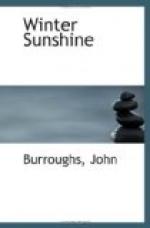I am not thinking especially of the Indian summer, that charming but uncertain second youth of the New England year, but of regularly recurring lucid intervals in the weather system of Virginia fall and winter, when the best our climate is capable of stand revealed,—southern days with northern blood in their veins, exhilarating, elastic, full of action, the hyperborean oxygen of the North tempered by the dazzling sun of the South, a little bitter in winter to all travelers but the pedestrian,—to him sweet and warming,—but in autumn a vintage that intoxicates all lovers of the open air.
It is impossible not to dilate and expand under such skies. One breathes deeply and steps proudly, and if he have any of the eagle nature in him, it comes to the surface then. There is a sense of altitude about these dazzling November and December days, of mountain-tops and pure ether. The earth in passing through the fire of summer seems to have lost all its dross, and life all its impediments.
But what does not the dweller in the National Capital endure in reaching these days! Think of the agonies of the heated term, the ragings of the dog-star, the purgatory of heat and dust, of baking, blistering pavements, of cracked and powdered fields, of dead, stifling night air, from which every tonic and antiseptic quality seems eliminated, leaving a residuum of sultry malaria and all-diffusing privy and sewer gases, that lasts from the first of July to near the middle of September! But when October is reached, the memory of these things is afar off, and the glory of the days is a perpetual surprise.
I sally out in the morning with the ostensible purpose of gathering chestnuts, or autumn leaves, or persimmons, or exploring some run or branch. It is, say, the last of October or the first of November. The air is not balmy, but tart and pungent, like the flavor of the red-cheeked apples by the roadside. In the sky not a cloud, not a speck; a vast dome of blue ether lightly suspended above the world. The woods are heaped with color like a painter’s palette,—great splashes of red and orange and gold. The ponds and streams bear upon their bosoms leaves of all tints, from the deep maroon of the oak to the pale yellow of the chestnut. In the glens and nooks it is so still that the chirp of a solitary cricket is noticeable. The red berries of the dogwood and spice-bush and other shrubs shine in the sun like rubies and coral. The crows fly high above the earth, as they do only on such days, forms of ebony floating across the azure, and the buzzards look like kingly birds, sailing round and round.




